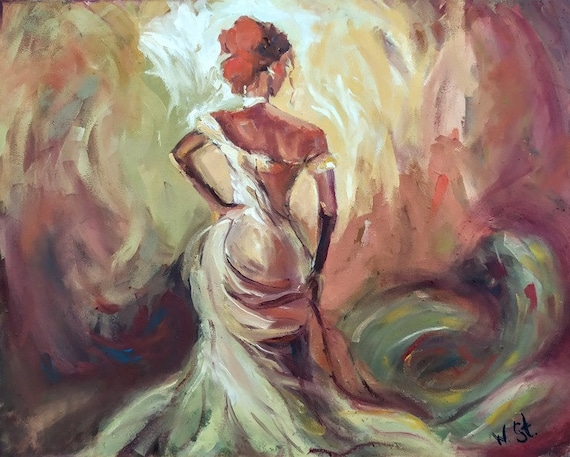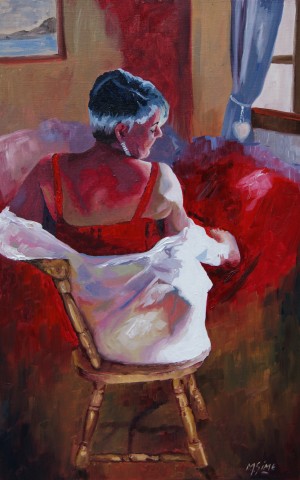Unveiling the Secrets Behind Meaningful Figurative Oil Painting Styles
Wiki Article
The Role of Feeling and Expression in Figurative Oil Paint: A Comprehensive Evaluation of Subject and Composition
The interplay of feeling and expression in figurative oil painting acts as a vital lens where one can analyze the intricate relationship in between subject and structure. Artists harness numerous methods, from shade choice to brushstroke dynamics, to cultivate emotional resonance within their works. This nuanced orchestration not just forms audience perception but additionally welcomes a much deeper questions right into just how these elements coalesce to reflect the intricacies of human experience. As we discover this rich terrain, one should consider just how certain study light up the more comprehensive ramifications of these imaginative options.Understanding Emotion in Art
Feeling in art works as a powerful channel for expression, allowing artists to communicate complex feelings with their work. In figurative oil paint, this psychological depth is usually depicted with the representation of the human figure, recording the nuances of human experience. The choice of subject issue, shade palette, and brushwork all contribute to the psychological vibration of an item.Artists frequently bring into play individual experiences, societal problems, or global themes to stimulate feelings in the audience. For example, a picture may mirror susceptability, while a dynamic number in activity can signify freedom or turmoil. These emotional threads link the customer to the art work, fostering a dialogue that transcends the visual medium.
Additionally, the interaction in between light and darkness can magnify psychological strength, leading the customer's stare and attracting focus to particular elements within the structure. The use of appearance in oil paint further adds layers of complexity, inviting a responsive response that boosts the emotional experience. Overall, understanding emotion in art is important for valuing the nuances that identify metaphorical oil paint, as it changes plain representation right into an extensive exploration of the human problem.
Crucial Element of Make-up
In the realm of metaphorical oil painting, the structure functions as the underlying framework that arranges aesthetic components and enhances the psychological narrative. Necessary elements of composition consist of balance, contrast, focal factor, and rhythm, each adding to the overall influence of the art work.Balance refers to the circulation of aesthetic weight within the paint, which can be achieved through asymmetrical or in proportion plans. A healthy structure provides security, permitting the viewer to engage with the item harmoniously - figurative oil painting. Comparison, on the other hand, involves comparing different components, such as dark and light or warm and trendy shades, to assist the visitor's eye and stimulate emotional actions
The centerpiece is vital, as it directs interest to one of the most considerable part of the painting, typically highlighting the psychological core of the narrative. With methods like shade saturation or placement, artists can stress this location successfully. Rhythm pertains to the rep of aspects, creating a sense of activity and flow throughout the structure. By masterfully incorporating these key components, musicians can craft engaging and mentally powerful figurative oil paints that astound and involve their target market.
Topic and Its Effect
Subject plays an essential role in figurative oil painting, as it not just functions as the structure for the narrative yet also shapes the visitor's analysis and emotional involvement with the artwork. The selection of subject matter-- be it a solitary number, a group dynamic, or a thematic depiction-- straight affects the emotional ambience communicated to the audience.
As an example, portraits commonly evoke individual links, disclosing the intricacies of human expression and personality, while scenes showing public tasks can create a feeling of belonging or nostalgia. Additionally, the social and historic context of the subject issue enriches the audience's understanding, motivating deeper representations on societal norms, worths, and the human condition.
Various check subject matters also generate varying degrees of interaction; a remarkable dispute illustrated through numbers in stress might generate sensations of anxiety or compassion, while serene landscapes can invoke tranquility and consideration. Ultimately, the impact of topic in metaphorical oil painting is extensive, as it acts as an avenue for psychological vibration, leading the audience's feedback and analysis, and promoting a connection in between the art work and the viewer. This interaction is important for the effective interaction of the musician's intent.
Methods for Evoking Sensations
The performance of figurative oil painting in communicating emotions is dramatically affected by the methods utilized by the musician. One of the most essential approaches is making use of shade theory, where the calculated choice of tones can evoke particular psychological feedbacks. Cozy shades, such as oranges and reds, commonly generate feelings of interest or aggression, while cooler tones like blues and environment-friendlies have a tendency to evoke peace or sadness.One more crucial method is the manipulation of light and shadow, referred to as chiaroscuro. This method enhances the three-dimensionality of numbers, developing significant contrasts that can escalate emotional deepness. The placement of light can direct audiences' feelings, highlighting particular elements of the composition.
Brushwork also plays a crucial function; loose, expressive strokes can communicate energy and spontaneity, whereas smoother strategies may recommend tranquility or accuracy. Furthermore, the arrangement of topics within the make-up can influence emotional impact. Close proximity can suggest intimacy, while range may indicate isolation.
Eventually, the mix of these techniques makes it possible for musicians to craft narratives that resonate with the audience, changing a plain aesthetic experience right into an expressive emotional journey. - figurative oil painting

Study of Significant Works
Analyzing remarkable jobs of metaphorical oil painting exposes just how numerous strategies are utilized to evoke effective feelings. One excellent situation is Edvard Munch's "The Scream," where the distorted number and swirling history share existential fear. Munch's use color-- brilliant oranges and deep blues-- escalates the psychological influence, showcasing how scheme selections can shape audience experience.One more significant job is Pablo Picasso's "Les Demoiselles d'Avignon." Right here, fragmented forms and strong brushstrokes reflect a tumultuous psychological landscape, testing conventional depictions of the female number. Picasso's innovative composition not only catches the audience's attention but also welcomes reflection on styles of identification and sexuality.
Furthermore, Frida Kahlo's "The 2 Fridas" uses an emotional expedition of duality and self-identity. The contrasting figures, connected by a shared heart, exemplify this contact form Kahlo's psychological depth and personal story. figurative oil painting. Her precise focus to information and symbolic aspects serve to involve audiences on a natural level
These instance studies emphasize the extensive link between feeling and composition in figurative oil painting, disclosing just how musicians harness method to interact intricate sensations and stories that reverberate throughout time and society.

Conclusion
To conclude, the interaction of emotion and expression in figurative oil paint significantly improves the audience's experience and analysis of the artwork. With a mindful choice of topic and compositional techniques, musicians communicate profound narratives that reverberate on both universal and individual degrees. The application of color chiaroscuro, theory, and brushwork additional amplifies emotional depth, changing each canvas into an effective reflection of the complexities of the human experience.In figurative oil paint, this psychological depth is often portrayed with the representation of the human number, capturing the nuances of human experience.In addition, the interplay in between light and darkness can magnify psychological intensity, directing the customer's look and drawing interest to certain elements within the structure. The use of appearance in oil paint further adds layers of complexity, welcoming a tactile feedback that improves the psychological experience.The focal point is critical, as it routes interest to the most significant part of the paint, commonly highlighting the psychological core of the narrative. Ultimately, the influence of subject issue in figurative oil painting i was reading this is extensive, as it offers as an avenue for emotional vibration, assisting the customer's response and analysis, and cultivating a link between the viewer and the artwork.
Report this wiki page